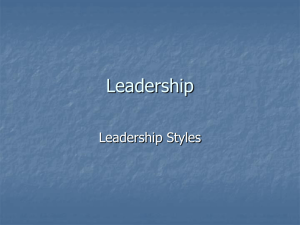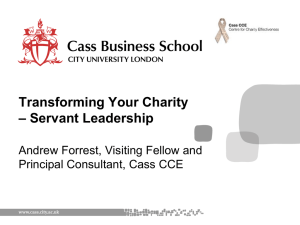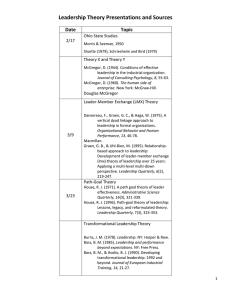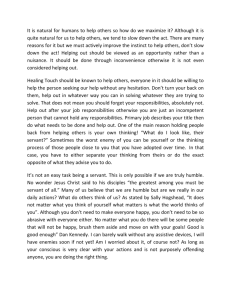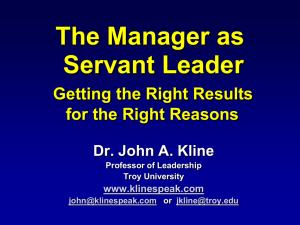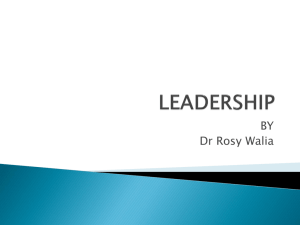Wholehearted Leadership - Servant Leaders in Education
advertisement
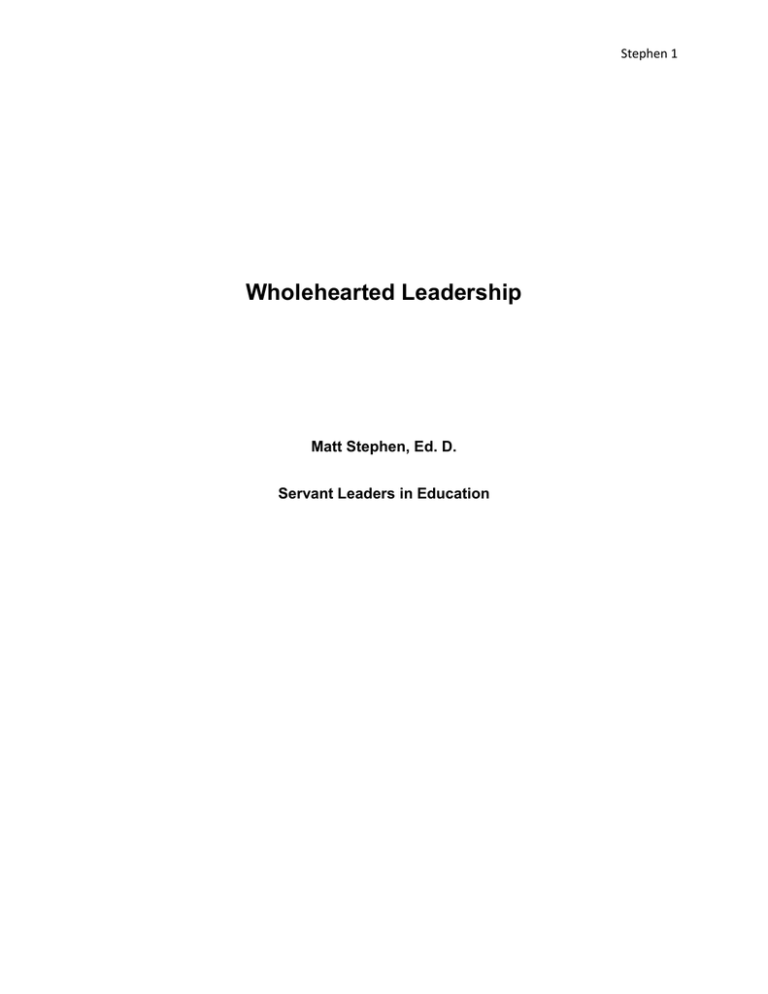
Stephen 1 Wholehearted Leadership Matt Stephen, Ed. D. Servant Leaders in Education Stephen 2 Wholehearted Leadership If asked, “What is your leadership style?” I suspect that many educators would reply, “I don’t know,” or “I haven’t thought about that.” Educators simply do not have the time to research the professional literature to compare the effectiveness of various leadership styles or to analyze their own leadership actions. Our leadership style serves to guide every thought and action that we take with our students each day; therefore, the selection of leadership style will greatly determine our success or failure as an educator working with children. Also, leadership style is a reflection of one’s personality and mission in life, so it is important that we take the time to reflect upon our thoughts and actions that make us who we are. Three Current Leadership Styles for Educators What is the best leadership style for educators? Three of the top contenders for the best leadership style for school leaders are relational leadership, servant leadership, and transformational leadership (RST). Servant Leadership. A servant leader is committed to a mission of service to others. Although numerous and varied definitions for servant leadership can be found in the research literature, James Laub (1999) took servant leadership beyond a simple definition of leadership style when he stated, “Servant leadership is more than a style of leadership. It is a different way of thinking about the purpose of leadership, the true role of a leader, and the potential of those being led” (p.30). Perhaps Laub gave us the simplest and most concise definition of servant leadership when he stated, “Servant Stephen 3 leadership is an understanding and practice of leadership that places the good of those led over the self-interest of the leader” (p.81). Relational Leadership. A relational leader is in touch with the inter- and intrarelationships that influence an organization. Relationship leadership behaviors are used to help workers “feel comfortable with themselves, the situation and each other” (Northouse, 2004, p. 3) by promoting mutual trust and collaboration, demonstrating concern for workers’ needs, empowering employees to contribute to the workplace, and encouraging healthy, respectful, and supportive working relationships between leaders and employees (Northouse, 2004). Transformational Leadership. A transformational leader is totally committed to a vision and motivating others to join in that vision. According to transformational leadership theory, transformational leaders influence followers’ self-definitions, affect, values, beliefs, and behaviors. They also empower followers to recognize the importance of their work and develop their knowledge, skills and abilities to reach their full potential. Thus, transformational leaders are likely to be associated with empowered followers who possess strong identification with their organizations. Transformational leaders also display individualized consideration by paying special attention to specific followers’ needs for personal growth and achievement, and trying to meet their needs and satisfy their expectations for future development (Bass, 1985). A New Leadership Style is Born At the intersection of the three leadership styles is the school leader who is committed to serving others through building meaningful relationships to promote Stephen 4 growth and development of people in order to transform schools. I propose that this intersection of SRT represents the best leadership style for educators. I call this leadership style “Wholehearted Leadership.” Figure 1: Intersection of Leadership Styles Wholehearted Leadership is total commitment to serving others through building meaningful relationships in order to help other people grow and develop. Developing Wholehearted Leaders in Schools All educators hold leadership roles in schools at various levels. Although leadership responsibilities and accountabilities vary, school leaders share a common leadership style: wholehearted leadership. To develop wholehearted leadership, one must answer the following questions through reflection and self-examination. Who am I? It is important to thoroughly understand oneself before in order to build a personal leadership style. Through personal reflection, one should answer these questions: 1. What are my values, beliefs, and guiding principles? Stephen 5 2. What is my personality and how do I interact with others? 3. What are my leadership strengths and weaknesses? 4. What is my philosophy regarding leading others? 5. What are my visions for me for the future? What is my Mission? To determine one’s mission, one must thoroughly explore the question, “Why am I here?” or “Why do I get out of bed each morning?” Once we are fully aware of whom we are, we can then focus on what role we play in this world. A mission of wholehearted service will ensure that a person’s vision and focus are on others rather than self. Putting one’s mission on paper ensures it will be well-thought out and comprehensive. A written mission also encourages daily reflection and periodic revision. A written mission can be articulated and shared with others. How will I accomplish this mission? Once a thorough understanding of self occurs and a mission is established, we can begin to examine steps to take in order to achieve that mission. Steps to achieve wholehearted service should at a minimum include the following concepts: 1. Building Meaningful Relationships 2. Developing Others 3. Sharing Leadership and Empower Others 4. Building Shared Vision and Mission 5. Focusing on the Big Picture 6. Motivating and Inspiring Others 7. Modeling Wholehearted Leadership Principles Stephen 6 Conclusion Wholehearted Leadership is one’s total commitment to serving others through building meaningful relationships in order to help other people grow and develop. By nature, this leadership occurs throughout schools: in the classrooms, on the practice fields, at PTA meetings, at school district offices, etc. The creation of meaningful relationships with students and dedication to helping them create their best futures are what educators do every day. Stephen 7 References Bass, B. M. (1985). Leadership and performance beyond expectations. New York, NY: Free Press. Laub, J. A. (1999). Assessing the servant organization: Development of the servant organizational leadership assessment (sola) instrument. Dissertation Abstracts International, 60 (02), 308A. (UMI No. 9921922) Northouse, P. G. (2004). Leadership: Theory and practice. Thousand Oaks, CA: Sage
